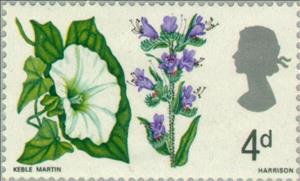Stamp: Larger Bindweed and Viper's Bugloss (phosphor) (United Kingdom of Great Britain & Northern Ireland 1967)
Larger Bindweed and Viper's Bugloss (phosphor) (United Kingdom of Great Britain & Northern Ireland 1967)
24 April (United Kingdom of Great Britain & Northern Ireland ) within release Wild Flowers goes into circulation Stamp Larger Bindweed and Viper's Bugloss (phosphor) face value 4 British penny
| Stamp Larger Bindweed and Viper's Bugloss (phosphor) in catalogues | |
|---|---|
| Michel: | Mi:GB 447y |
| Yvert et Tellier: | Yt:GB 466A |
| Stanley Gibbons: | Sg:GB 718p |
| AFA number: | AFA:GB 447D |
Stamp is horizontal format.
Three phosphor bandsAlso in the issue Wild Flowers:
- Stamp - Ox-eye Daisy, Coltsfoot and Buttercup (phosphor) face value 4;
- Stamp - Anemone nemorosa Hyacinthoides non-scripta Silende dioica face value 4;
- Stamp - Bluebell, Red Campion and Wood Anemone (phosphor) face value 4;
- Stamp - Larger Bindweed and Viper's Bugloss (phosphor) face value 4;
- Stamp - Leucanthemum vulgare Tussilago farfara Ranunculus acris face value 4;
- Stamp - Rubus fruticosa Crataegus monogyna face value 4;
- Stamp - Dog Violet (Viola Riviniana) face value 9;
- Stamp - Dog Violet (phosphor) face value 9;
- Stamp - Primrose (Primula vulgaris) face value 1'9;
- Stamp - Primroses (phosphor) face value 1'9;
- Stamp - Hawthorn and Bramble (phosphor) face value 4;
- Stamp - Calystegia sepium Echium vulgare face value 4;
- Stamp - Rubus fruticosa Crataegus monogyna face value 4;
- Stamp - Anemone nemorosa Hyacinthoides non-scripta Silende dioica face value 4;
- Se-tenant - British Wild Flowers face value 4*4;
- Stamp - Hawthorn and Bramble (phosphor) face value 4;
- Stamp - Leucanthemum vulgare Tussilago farfara Ranunculus acris face value 4;
- Stamp - Larger Bindweed and Viper's Bugloss (phosphor) face value 4;
- Stamp - Bluebell, Red Campion and Wood Anemone (phosphor) face value 4;
- Se-tenant - British Wild Flowers (Phosphor) face value 4*4;
- Stamp - Calystegia sepium Echium vulgare face value 4;
- Se-tenant - British Wild Flowers face value 4*4;
- Se-tenant - British Wild Flowers (Phosphor) face value 4*4;
- Stamp - Dog Violet (Viola Riviniana) face value 9;
- Stamp - Ox-eye Daisy, Coltsfoot and Buttercup (phosphor) face value 4;
Stamp Larger Bindweed and Viper's Bugloss (phosphor) it reflects the thematic directions:
A flower, sometimes known as a bloom or blossom, is the reproductive structure found in plants that are floral (plants of the division Magnoliophyta, also called angiosperms). The biological function of a flower is to effect reproduction, usually by providing a mechanism for the union of sperm with eggs. Flowers may facilitate outcrossing (fusion of sperm and eggs from different individuals in a population) or allow selfing (fusion of sperm and egg from the same flower). Some flowers produce diaspores without fertilization (parthenocarpy). Flowers contain sporangia and are the site where gametophytes develop. Many flowers have evolved to be attractive to animals, so as to cause them to be vectors for the transfer of pollen. After fertilization, the ovary of the flower develops into fruit containing seeds. In addition to facilitating the reproduction of flowering plants, flowers have long been admired and used by humans to beautify their environment, and also as objects of romance, ritual, religion, medicine and as a source of food.
Flora is the plant life occurring in a particular region or time, generally the naturally occurring or indigenous—native plant life. The corresponding term for animal life is fauna. Flora, fauna and other forms of life such as fungi are collectively referred to as biota. Sometimes bacteria and fungi are also referred to as flora, as in the terms gut flora or skin flora.


